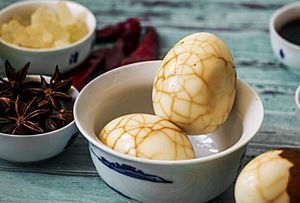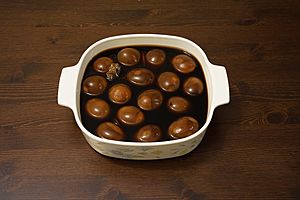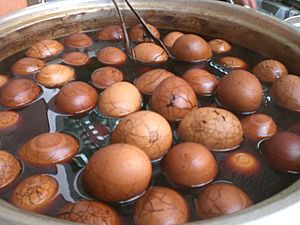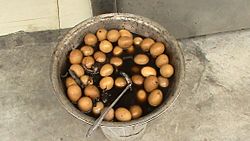Tea egg facts for kids
 |
|
| Course | Snack |
|---|---|
| Place of origin | China |
| Region or state | Zhejiang |
| Main ingredients | Egg, five-spice powder, Tea |
| Tea egg | |||||||||||
|---|---|---|---|---|---|---|---|---|---|---|---|
| Traditional Chinese | 茶葉蛋 | ||||||||||
| Simplified Chinese | 茶叶蛋 | ||||||||||
| Literal meaning | tea leaf egg | ||||||||||
|
|||||||||||
| Alternative Chinese name | |||||||||||
| Traditional Chinese | 茶葉卵 | ||||||||||
|
|||||||||||
A tea egg is a yummy Chinese snack. It's a boiled egg that gets a special makeover! People also call it a marble egg because of the cool patterns on its shell. These patterns look like marble!
You can often find tea eggs sold by street vendors or in busy night markets. They are popular in Chinese communities all over the world. You might also see them in Asian restaurants. Even though tea eggs started in China, other countries in Asia have their own similar recipes. Tea eggs first came from a place in China called Zhejiang province. They were a way to keep food fresh for a long time. Now, you can find them in all parts of China.
Contents
How to Make Tea Eggs
Making tea eggs is a fun process. There are two main ways to do it. Both methods make the eggs taste great!
The Traditional Way
The traditional way to make tea eggs gives them a wonderful smell and flavor. This recipe uses different spices, soy sauce, and black tea leaves. A common spice mix is five-spice powder. This powder has ground cinnamon, star anise, fennel seeds, cloves, and Sichuan pepper. Sometimes, recipes don't even use tea leaves, but they are still called "tea eggs."
First, eggs are boiled until they are fully cooked and hard. Then, you carefully take the boiled eggs out of the water. Gently crack the entire shell of each egg. Making small cracks creates more of the cool marble pattern when you peel the egg later. Let any extra water drain from the eggs.
After about ten minutes, the cracked eggs are ready. You put them into a special liquid made of spiced tea. Then, you simmer them over medium heat. This simmering lets the spiced liquid soak into the cracks. It helps the eggs get all the flavors inside their shells. After about twenty minutes, you move the eggs and liquid to a glass or ceramic container. You then put them in the refrigerator to steep even more. For the best taste, let the eggs steep for at least a few hours. The dark color from the spiced tea gives the egg that amazing marble look when you peel it.
The Quick Way
Another way to make tea eggs is quicker. First, boil the eggs until they are fully cooked and hard. Then, remove the shells from the hard-boiled eggs. After that, let them soak in the spiced tea mixture over low heat for a short time.
Take the eggs and liquid off the heat. Move them to a glass or ceramic container for more steeping. This method takes less time to steep than the traditional way. However, the egg won't have the cool marble pattern because the shell is removed. You can eat these eggs anytime. The longer they steep, the stronger and richer the flavor will be. A perfect tea egg has a good balance between the egg's natural taste and the spices.
This quick method makes a tea egg that is very similar to a soy egg.
What Tea Eggs Look and Taste Like
When you peel a tea egg, you'll see areas of light and dark brown. There's a brownish color along the lines where the shell was cracked. The yolk inside is usually yellow. If an egg is cooked for too long, it might have a thin, harmless grayish layer around the yolk, but the center will still be yellow.
The taste of a tea egg depends on the type and strength of the tea used. It also depends on the different spices. Five-spice powder adds a savory, slightly salty taste to the egg white. The tea helps bring out the flavor of the yolk.
Tea Eggs Around Asia
Tea eggs are popular in many parts of Asia, each with its own special touch.
China
In China, tea eggs are a common treat in homes. You can also buy them in stores, restaurants, and from street vendors. They are a popular street food and usually cost about 2 yuan.
Taiwan
In Taiwan, tea eggs are a regular item in convenience stores. For example, the 7-Eleven stores alone sell about 40 million tea eggs every year! Recently, some companies that make tea eggs have started creating new flavors. These include fruit-flavored eggs like raspberry and blueberry, and even salted duck eggs.
Indonesia
In Indonesia, tea eggs have become part of their own local food, called telur pindang. The ingredients are a bit different. Telur pindang are hard-boiled eggs cooked with spices, salt, and soy sauce. But instead of black tea, the Indonesian version uses leftover shallot skins, teak leaves, or guava leaves. These natural ingredients give the eggs a dark brownish color. Telur pindang is common in Indonesia, especially in Java and South Sumatra. It's often served with dishes like tumpeng, nasi kuning, or nasi campur. In Yogyakarta, telur pindang is often eaten with nasi gudeg or just hot steamed rice.
Malaysia
Telur pindang, the Malaysian version of the tea egg, is thought to have started in the state of Johor. It's most popular there, but you can find it in other parts of the Malay Peninsula too. There are even different versions of the traditional Johorean recipe in many southern regions. Telur pindang used to be a special dish. It took a lot of time and effort to make, so it was only served at big events like weddings. But today, many companies sell telur pindang all over the country.




